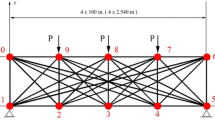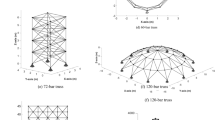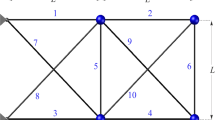Abstract
Performing the design of a truss including topological, shape and sizing (TSS) variables simultaneously is a challenging but important task for a designer. It is even more interesting when the design problem involves random parameters. In this paper, a novel hybrid meta-heuristic based on the whale optimisation algorithm (WOA) and success history–based adaptive differential evolution (SHADE) is developed to solve the multi-objective reliability optimisation of a truss. The reliability design problem is assigned as a bi-objective truss optimisation with mass and reliability index being the objectives. Two novel algorithms called success history–based adaptive multi-objective differential evolution (SHAMODE) and success history–based adaptive multi-objective differential evolution with whale optimisation (SHAMODE-WO) are developed in this paper. The proposed algorithms are used to solve the test problems for TSS truss reliability optimisation along with some established optimisers. Comparative results show that they are among the top algorithms in solving such design problems. Moreover, SHAMODE-WO shows obvious improvement compared to SHAMODE.










Similar content being viewed by others
References
Ahrari A, Atai AA, Deb K (2015) Simultaneous topology, shape and size optimization of truss structures by fully stressed design based on evolution strategy. Eng Optim 47:1063–1084. https://doi.org/10.1080/0305215X.2014.947972
Aittokoski T, Miettinen K (2010) Efficient evolutionary approach to approximate the Pareto-optimal set in multiobjective optimization, UPS-EMOA. Optim Methods Softw 25:841–858. https://doi.org/10.1080/10556780903548265
Awad NH, Ali MZ, Suganthan PN (2017) Ensemble sinusoidal differential covariance matrix adaptation with Euclidean neighborhood for solving CEC2017 benchmark problems. In: 2017 IEEE Congress on Evolutionary Computation (CEC). IEEE, pp 372–379
Awad NH, Ali MZ, Suganthan PN, Reynolds RG (2016) An ensemble sinusoidal parameter adaptation incorporated with L-SHADE for solving CEC2014 benchmark problems. In: 2016 IEEE Congress on Evolutionary Computation (CEC). IEEE:2958–2965
Barroso ES, Parente E, Cartaxo de Melo AM (2017) A hybrid PSO-GA algorithm for optimization of laminated composites. Struct Multidiscip Optim 55:2111–2130. https://doi.org/10.1007/s00158-016-1631-y
Brest J, Greiner S, Boskovic B et al (2006) Self-adapting control parameters in differential evolution: a comparative study on numerical benchmark problems. IEEE Trans Evol Comput 10:646–657. https://doi.org/10.1109/TEVC.2006.872133
Brest J, Maucec MS, Boskovic B (2016) iL-SHADE: improved L-SHADE algorithm for single objective real-parameter optimization. In: 2016 IEEE Congress on Evolutionary Computation (CEC). IEEE, pp 1188–1195
Bureerat S, Pholdee N (2016) Optimal truss sizing using an adaptive differential evolution algorithm. J Comput Civ Eng 30:04015019. https://doi.org/10.1061/(ASCE)CP.1943-5487.0000487
Bureerat S, Srisomporn S (2010) Optimum plate-fin heat sinks by using a multi-objective evolutionary algorithm. Eng Optim 42:305–323. https://doi.org/10.1080/03052150903143935
Bureerat S, Sriworamas K (2013) Simultaneous topology and sizing optimization of a water distribution network using a hybrid multiobjective evolutionary algorithm. Appl Soft Comput 13:3693–3702. https://doi.org/10.1016/j.asoc.2013.04.005
Bureerat S, Sriworamas K (2007) Population-based incremental learning for multiobjective optimisation. In: Soft computing in industrial applications. Springer Berlin Heidelberg, Berlin, pp 223–232
Coello Coello CA, Reyes-Sierra M (2006) Multi-objective particle swarm optimizers: a survey of the state-of-the-art. Int J Comput Intell Res 2. https://doi.org/10.5019/j.ijcir.2006.68
Cornell CA (1969) A probability-based structural code. J Am Concr Inst 66. https://doi.org/10.14359/7446
Das S, Suganthan PN (2011) Differential evolution: a survey of the state-of-the-art. IEEE Trans Evol Comput 15:4–31. https://doi.org/10.1109/TEVC.2010.2059031
Deb K, Jain H (2014) An evolutionary many-objective optimization algorithm using reference-point-based nondominated sorting approach, part I: solving problems with box constraints. IEEE Trans Evol Comput 18:577–601. https://doi.org/10.1109/TEVC.2013.2281535
Deb K, Pratap A, Agarwal S, Meyarivan T (2002) A fast and elitist multiobjective genetic algorithm: NSGA-II. IEEE Trans Evol Comput 6:182–197. https://doi.org/10.1109/4235.996017
Dorigo M, Di Caro G (1999) Ant colony optimization: a new meta-heuristic. In: Proceedings of the 1999 congress on evolutionary computation-CEC99 (Cat. No. 99TH8406). IEEE, pp 1470–1477
Eberhart R, Kennedy J (1995) A new optimizer using particle swarm theory. In: MHS’95. Proceedings of the sixth international symposium on micro machine and human science. IEEE, pp 39–43
Elsayed SM, Sarker RA, Essam DL (2013) A genetic algorithm for solving the CEC’2013 competition problems on real-parameter optimization. In: 2013 IEEE congress on evolutionary computation. IEEE, pp 356–360
Gholizadeh S, Poorhoseini H (2016) Seismic layout optimization of steel braced frames by an improved dolphin echolocation algorithm. Struct Multidiscip Optim 54:1011–1029. https://doi.org/10.1007/s00158-016-1461-y
Greiner D, Hajela P (2012) Truss topology optimization for mass and reliability considerations—co-evolutionary multiobjective formulations. Struct Multidiscip Optim 45:589–613. https://doi.org/10.1007/s00158-011-0709-9
Guo S-M, Tsai JS-H, Yang C-C, Hsu P-H (2015) A self-optimization approach for L-SHADE incorporated with eigenvector-based crossover and successful-parent-selecting framework on CEC 2015 benchmark set. In: 2015 IEEE Congress on Evolutionary Computation (CEC). IEEE, pp 1003–1010
Ho-Huu V, Duong-Gia D, Vo-Duy T et al (2018) An efficient combination of multi-objective evolutionary optimization and reliability analysis for reliability-based design optimization of truss structures. Expert Syst Appl 102:262–272. https://doi.org/10.1016/j.eswa.2018.02.040
Holland JH (1962) Outline for a logical theory of adaptive systems. J ACM 9:297–314. https://doi.org/10.1145/321127.321128
Holland JH (1998) Adaptation in natural and artificial systems: an introductory analysis with applications to biology, control, and artificial intelligence
Jain H, Deb K (2014) An evolutionary many-objective optimization algorithm using reference-point based nondominated sorting approach, part II: handling constraints and extending to an adaptive approach. IEEE Trans Evol Comput 18:602–622. https://doi.org/10.1109/TEVC.2013.2281534
Jayalakshmi V, Rao ARM (2017) Simultaneous identification of damage and input dynamic force on the structure for structural health monitoring. Struct Multidiscip Optim 55:2211–2238. https://doi.org/10.1007/s00158-016-1637-5
Kanyakam S, Bureerat S (2007) Passive vibration suppression of a walking tractor handlebar structure using multiobjective PBIL. In: 2007 IEEE congress on evolutionary computation. IEEE, pp 4162–4169
Karaboga D, Basturk B (2007) A powerful and efficient algorithm for numerical function optimization: artificial bee colony (ABC) algorithm. J Glob Optim 39:459–471. https://doi.org/10.1007/s10898-007-9149-x
Kaveh A (Ali) (2004) Structural mechanics: graph and matrix methods. Research Studies
Kaveh A, Ahmadi B (2014) Sizing, geometry and topology optimization of trusses using force method and supervised charged system search. Struct Eng Mech 50:365–382. https://doi.org/10.12989/sem.2014.50.3.365
Kaveh A, Hassani B, Shojaee S, Tavakkoli SM (2008) Structural topology optimization using ant colony methodology. Eng Struct 30:2559–2565. https://doi.org/10.1016/J.ENGSTRUCT.2008.02.012
Kaveh A, Kalatjari V (2003) Topology optimization of trusses using genetic algorithm, force method and graph theory. Int J Numer Methods Eng 58:771–791. https://doi.org/10.1002/nme.800
Kaveh A, Laknejadi K (2011) A hybrid multi-objective optimization and decision making procedure for optimal design of truss structures. Iran J Sci Technol Civ Eng 35:137–154. https://doi.org/10.22099/IJSTC.2012.663
Kaveh A, Mahdavi Dahoei VR (2015) Colliding bodies optimization for size and topology optimization of truss structures. Struct Eng Mech 53:847–865. https://doi.org/10.12989/sem.2015.53.5.847
Kaveh A, Rezaei M (2016) Topology and geometry optimization of single-layer domes utilizing CBO and ECBO. Sci Iran 23:535–547. https://doi.org/10.24200/sci.2016.2137
Kaveh A, Shahrouzi M (2006) Simultaneous topology and size optimization of structures by genetic algorithm using minimal length chromosome. Eng Comput 23:644–674. https://doi.org/10.1108/02644400610680351
Kaveh A, Talatahari S (2011) Geometry and topology optimization of geodesic domes using charged system search. Struct Multidiscip Optim 43:215–229. https://doi.org/10.1007/s00158-010-0566-y
Kennedy J (1997) The particle swarm: social adaptation of knowledge. In: Proceedings of 1997 IEEE international conference on evolutionary computation (ICEC ’97). IEEE, pp 303–308
Lakshmi K, Rao ARM (2013) Optimal design of laminate composite isogrid with dynamically reconfigurable quantum PSO. Struct Multidiscip Optim 48:1001–1021. https://doi.org/10.1007/s00158-013-0943-4
Li B, Li J, Tang K, Yao X (2014) An improved two archive algorithm for many-objective optimization. In: 2014 IEEE Congress on Evolutionary Computation (CEC). IEEE, pp 2869–2876
Liang JJ, Guo L, Liu R, Qu BY (2015) A self-adaptive dynamic particle swarm optimizer. In: 2015 IEEE Congress on Evolutionary Computation (CEC). IEEE, pp 3206–3213
Lin G, Guan J (2018) Solving maximum set k -covering problem by an adaptive binary particle swarm optimization method. Knowledge-Based Syst 142:95–107. https://doi.org/10.1016/j.knosys.2017.11.028
Liu J, Lampinen J (2005) A fuzzy adaptive differential evolution algorithm. Soft Comput 9:448–462. https://doi.org/10.1007/s00500-004-0363-x
Livani MA, Khaji N, Zakian P (2018) Identification of multiple flaws in 2D structures using dynamic extended spectral finite element method with a universally enhanced meta-heuristic optimizer. Struct Multidiscip Optim 57:605–623. https://doi.org/10.1007/s00158-017-1767-4
Ma X, Liu F, Qi Y et al (2014) MOEA/D with Baldwinian learning inspired by the regularity property of continuous multiobjective problem. Neurocomputing 145:336–352. https://doi.org/10.1016/j.neucom.2014.05.025
Mallipeddi R, Suganthan PN, Pan QK, Tasgetiren MF (2011) Differential evolution algorithm with ensemble of parameters and mutation strategies. Appl Soft Comput 11:1679–1696. https://doi.org/10.1016/j.asoc.2010.04.024
Mirjalili S, Lewis A (2016) The whale optimization algorithm. Adv Eng Softw 95:51–67. https://doi.org/10.1016/j.advengsoft.2016.01.008
Mlakar M, Petelin D, Tušar T, Filipič B (2015) GP-DEMO: differential evolution for multiobjective optimization based on Gaussian process models. Eur J Oper Res 243:347–361. https://doi.org/10.1016/j.ejor.2014.04.011
Mohamed AW, Hadi AA, Fattouh AM, Jambi KM (2017) LSHADE with semi-parameter adaptation hybrid with CMA-ES for solving CEC 2017 benchmark problems. In: 2017 IEEE Congress on Evolutionary Computation (CEC). IEEE, pp 145–152
Noilublao N, Bureerat S (2011) Simultaneous topology, shape and sizing optimisation of a three-dimensional slender truss tower using multiobjective evolutionary algorithms. Comput Struct 89:2531–2538. https://doi.org/10.1016/j.compstruc.2011.08.010
Nseef SK, Abdullah S, Turky A, Kendall G (2016) An adaptive multi-population artificial bee colony algorithm for dynamic optimisation problems. Knowledge-Based Syst 104:14–23. https://doi.org/10.1016/j.knosys.2016.04.005
Panagant N, Bureerat S (2018) Truss topology, shape and sizing optimization by fully stressed design based on hybrid grey wolf optimization and adaptive differential evolution. Eng Optim 50:1645–1661. https://doi.org/10.1080/0305215X.2017.1417400
Park S, Choi S, Sikorsky C, Stubbs N (2004) Efficient method for calculation of system reliability of a complex structure. Int J Solids Struct 41:5035–5050. https://doi.org/10.1016/j.ijsolstr.2004.04.028
Pholdee N, Bureerat S (2018) A comparative study of eighteen self-adaptive metaheuristic algorithms for truss sizing optimisation. KSCE J Civ Eng 22:2982–2993. https://doi.org/10.1007/s12205-017-0095-y
Pholdee N, Bureerat S (2014) Hybrid real-code population-based incremental learning and approximate gradients for multi-objective truss design. Eng Optim 46:1032–1051. https://doi.org/10.1080/0305215X.2013.823194
Pholdee N, Bureerat S (2013) Hybridisation of real-code population-based incremental learning and differential evolution for multiobjective design of trusses. Inf Sci (NY) 223:136–152. https://doi.org/10.1016/j.ins.2012.10.008
Polakova R, Tvrdik J, Bujok P (2016) Evaluating the performance of L-SHADE with competing strategies on CEC2014 single parameter-operator test suite. In: 2016 IEEE Congress on Evolutionary Computation (CEC). IEEE, pp 1181–1187
Praditwong K, Yao X (2006) A new multi-objective evolutionary optimisation algorithm: the two-archive algorithm. In: 2006 international conference on computational intelligence and security. IEEE, pp 286–291
Price KV (1997) Differential evolution vs. the functions of the 2/sup nd/ICEO. In: Proceedings of 1997 IEEE international conference on evolutionary computation (ICEC ’97). IEEE, pp 153–157
Qin AK, Suganthan PN (2005) Self-adaptive differential evolution algorithm for numerical optimization. In: 2005 IEEE congress on evolutionary computation. IEEE, pp 1785–1791
Rahami H, Kaveh A, Gholipour Y (2008) Sizing, geometry and topology optimization of trusses via force method and genetic algorithm. Eng Struct 30:2360–2369. https://doi.org/10.1016/J.ENGSTRUCT.2008.01.012
Rao RV, Savsani VJ, Vakharia DP (2011) Teaching–learning-based optimization: a novel method for constrained mechanical design optimization problems. Comput Des 43:303–315. https://doi.org/10.1016/j.cad.2010.12.015
Robič T, Filipič B (2005) DEMO: differential evolution for multiobjective optimization. Springer, Berlin, pp 520–533
Sallam KM, Sarker RA, Essam DL, Elsayed SM (2015) Neurodynamic differential evolution algorithm and solving CEC2015 competition problems. In: 2015 IEEE Congress on Evolutionary Computation (CEC). IEEE, pp 1033–1040
Sivasubramani S, Swarup KS (2011) Environmental/economic dispatch using multi-objective harmony search algorithm. Electr Power Syst Res 81:1778–1785. https://doi.org/10.1016/j.epsr.2011.04.007
Srinivas N, Deb K (1994) Muiltiobjective optimization using nondominated sorting in genetic algorithms. Evol Comput 2:221–248. https://doi.org/10.1162/evco.1994.2.3.221
Storn R, Price K (1995) Differential evolution—a simple and efficient adaptive scheme for global optimization over continuous spaces
Storn R, Price K (1996) Minimizing the real functions of the ICEC’96 contest by differential evolution. In: Proceedings of IEEE International Conference on Evolutionary Computation. IEEE, pp 842–844
Tanabe R, Fukunaga A (2013) Success-history based parameter adaptation for differential evolution. In: 2013 IEEE congress on evolutionary computation. IEEE, pp 71–78
Tanabe R, Fukunaga A (2014) Improving the search performance of SHADE using linear population size reduction. In: 2014 IEEE Congress on Evolutionary Computation (CEC). IEEE, pp 1658–1665
Tanweer MR, Suresh S, Sundararajan N (2015) Improved SRPSO algorithm for solving CEC 2015 computationally expensive numerical optimization problems. In: 2015 IEEE Congress on Evolutionary Computation (CEC). IEEE, pp 1943–1949
Techasen T, Wansasueb K, Panagant N et al (2018) Simultaneous topology, shape, and size optimization of trusses, taking account of uncertainties using multi-objective evolutionary algorithms. Eng Comput. https://doi.org/10.1007/s00366-018-0629-z
Tejani GG, Pholdee N, Bureerat S, Prayogo D (2018a) Multiobjective adaptive symbiotic organisms search for truss optimization problems. Knowledge-Based Syst 161:398–414. https://doi.org/10.1016/j.knosys.2018.08.005
Tejani GG, Savsani VJ, Bureerat S, Patel VK (2018b) Topology and size optimization of trusses with static and dynamic bounds by modified symbiotic organisms search. J Comput Civ Eng 32:04017085. https://doi.org/10.1061/(ASCE)CP.1943-5487.0000741
Tejani GG, Savsani VJ, Patel VK, Bureerat S (2017) Topology, shape, and size optimization of truss structures using modified teaching-learning based optimization. Adv Comput Des 2. https://doi.org/10.12989/acd.2017.2.4.313
Tejani GG, Savsani VJ, Patel VK, Mirjalili S (2018c) Truss optimization with natural frequency bounds using improved symbiotic organisms search. Knowledge-Based Syst 143:162–178. https://doi.org/10.1016/j.knosys.2017.12.012
Teo J (2006) Exploring dynamic self-adaptive populations in differential evolution. Soft Comput 10:673–686. https://doi.org/10.1007/s00500-005-0537-1
Viktorin A, Pluhacek M, Senkerik R (2016) Success-history based adaptive differential evolution algorithm with multi-chaotic framework for parent selection performance on CEC2014 benchmark set. In: 2016 IEEE Congress on Evolutionary Computation (CEC). IEEE, pp 4797–4803
Wang H, Jiao L, Yao X (2015) Two_Arch2: an improved two-archive algorithm for many-objective optimization. IEEE Trans Evol Comput 19:524–541. https://doi.org/10.1109/TEVC.2014.2350987
Yang Z, Tang K, Yao X (2008) Self-adaptive differential evolution with neighborhood search. In: 2008 IEEE congress on evolutionary computation (IEEE world congress on computational intelligence). IEEE, pp 1110–1116
Yashesh D, Deb K, Bandaru S (2014) Non-uniform mapping in real-coded genetic algorithms. In: 2014 IEEE Congress on Evolutionary Computation (CEC). IEEE, pp 2237–2244
Zhang J, Sanderson AC (2009) JADE: adaptive differential evolution with optional external archive. IEEE Trans Evol Comput 13:945–958. https://doi.org/10.1109/TEVC.2009.2014613
Zhang Q, Li H (2007) MOEA/D: a multiobjective evolutionary algorithm based on decomposition. IEEE Trans Evol Comput 11:712–731. https://doi.org/10.1109/TEVC.2007.892759
Zhang X, Tian Y, Jin Y (2015) A knee point-driven evolutionary algorithm for many-objective optimization. IEEE Trans Evol Comput 19:761–776. https://doi.org/10.1109/TEVC.2014.2378512
Zitzler E, Laumanns M, Thiele L (2001) SPEA2: improving the strength pareto evolutionary algorithm for multiobjective optimization. In: Evolutionary methods for design optimization and control with applications to industrial problems
Funding
The study received support from the Thailand Research Fund (TRF) with grant number RTA6180010.
Author information
Authors and Affiliations
Corresponding author
Ethics declarations
Conflict of interest
The authors declare that they have no conflict of interest.
Additional information
Responsible Editor: Jianbin Du
Publisher’s note
Springer Nature remains neutral withregard to jurisdictional claims in published mapsand institutional affiliations.
Rights and permissions
About this article
Cite this article
Panagant, N., Bureerat, S. & Tai, K. A novel self-adaptive hybrid multi-objective meta-heuristic for reliability design of trusses with simultaneous topology, shape and sizing optimisation design variables. Struct Multidisc Optim 60, 1937–1955 (2019). https://doi.org/10.1007/s00158-019-02302-x
Received:
Revised:
Accepted:
Published:
Issue Date:
DOI: https://doi.org/10.1007/s00158-019-02302-x




